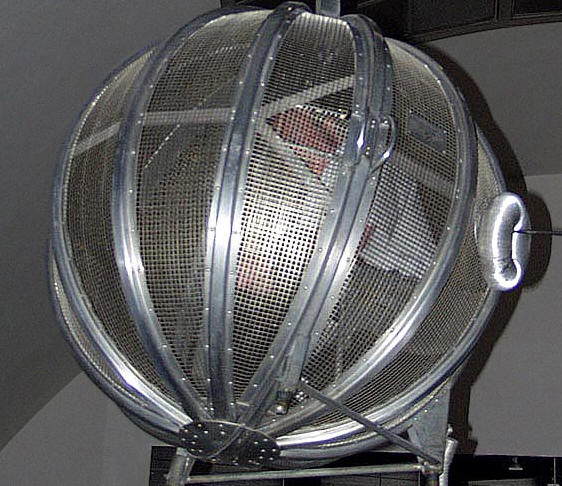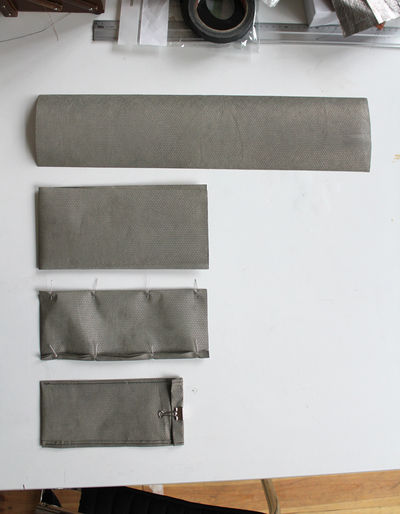Faraday Phone Pouch
From Gender and Tech Resources
Contents
[hide]The electromagnetic spectrum
The electromagnetic spectrum or electric radio spectrum is not something material, but the air space that goes from the ground to the highest part of the atmosphere. Frequency bands are organized in this space, which airplanes, wi-fi, bluetooth, walkie talkies, radios, and telephones use to communicate, for example 2G, 3G, 4G phone networks all use different bands of the electromagnetic space.
For more information about the electromagnetic space: https://imagine.gsfc.nasa.gov/science/toolbox/emspectrum1.html https://en.wikipedia.org/wiki/Electromagnetic_spectrum
Faraday Cage
The Faraday cage is a structure or item that blocks all electromagnetic fields from outside it to anything within it, meaning an electronic device that transmits signals - such as a phone - will note receive or transmit any signal within it.
The Faraday cage is based on the effect by which the electromagnetic field inside a conductor in equilibrium is null, and nullifies the effect of the external fields. This is because when the conductor is subjected to an external electromagnetic field, it is polarized, meaning it is positively charged in the direction of the electromagnetic field, and negatively charged in the opposite direction. Since the conductor has been polarized, it generates an electric field equal in magnitude but opposite in the direction of the electromagnetic field, so the sum of both fields inside the conductor will be equal to 0.
This effect is evident in many everyday situations, for example, the malfunction of mobile phones inside elevators or buildings with a steel grid structure. One way to check this is with a radio tuned to a Medium Wave radio station. When it is surrounded with a newspaper, the sound is heard correctly, but if we replace the paper with aluminum foil, the radio will cease to emit sounds: aluminum is an electric conductor and causes Faraday's cage effect. s This phenomenon, discovered by Michael Faraday in 1836, is essential for protecting sensitive electronic equipment, such as hard disks or radio and television repeaters, that are exposed to electromagnetic disturbances caused by storms, for example in exposed mountain-top antennas or in aircraft. This effect is also used to block the reading of RFID (Radio Frequency Identifiers) chips, which store personal information and can be intercepted by anyone with a radio-frequency scanner. These chips are found in objects such as passports, credit cards and some driver's licenses.
Mobile phones emit signals constantly, even when they are switched off, for example GPS signals, which reveal a phone's location no matter if it is off or on, or the network signal that enables a phone to be located using triangulation between phone masts. The fact that your phone has no signal (when you cannot call), does not mean that you are not locatable, or that you have stopped sending signals.
Some household appliances work as Faraday boxes, as a thick layer of metal can have the same effect, for example the freezer in the refrigerator; if a phone is put inside it prevents signals from being emitted.
About the Faraday cage: https://en.wikipedia.org/wiki/Faraday_cage
Experiment of creating a Farady cage: https://backyardbrains.com/experiments/faraday
How they can intercept the information on your phone
One way to intercept the information on your phone is through an IMSI-catcher, a device that can be installed anywhere (a car, a house nearby, etc.), and which simulates the antenna of a mobile phone mast. When installed, the cell phones for a specified network will automatically connect with this fake antenna. Thus, this device locates and identifies the phones that are in range, even if they are not communicating, registering or sending information that identifies them (such as telephone number and device number).
The IMSI-catcher can also relay the communications from a particular cell phone in such a way that the phone can not detect its presence. In this way an IMSI-catcher can have direct access to the content of from mobile phones and can use a mobile phone as a live listening device.
You can read a How To guide on IMSI-catchers here: https://gendersec.tacticaltech.org/wiki/index.php/Detect_false_mobile_antennas
Build a Faraday Pouch
There are several ways to make a bag for mobile devices or tablets so that they are not traceable and do not emit signals.
You'll need a conductive textile, which can be bought online in places like these:
The most important thing is that when you make the cover there is no gap from where the signal can leak. Make sure you sew all the edges, you can fold the textile before sewing it.
The sleeve can be made with a sewing machine or by hand. You can design a way to close it: with a button, with velcro, or simply with a clamp.
If the textile is not very thick or strong, you can use two layers. If you want to improve the appearance of your pouch, you can use another textile for the outer coating. You can try different designs and shapes, as shown in the drawing:
Additional safety measures for your pouch
Using Faraday pouches as a group can arouse suspicion. If for example, several monitored mobiles located in the same area, are switched off or no longer connected to the network at the same time, it could make it obvious that those people have something to hide or are doing something unusual. In that situation, the safest practice is still to leave your phone in the house, or at least remove the battery, or put it in the Faraday pouch before leaving your house so as not to reveal the meeting place.
Take extra care regarding sound, as the Faraday bag does not affect the microphone. Although the phone is incommunicado with the outside, a tool could have been installed that allows sound to be recorded and sent somewhere later. Be sure to keep the phone in an sound proof place; you can put the phone with its case inside an airtight glass jar, in the refrigerator, or in another room.
Other interesting links
http://briangreen.net/2010/11/diy-ultralight-faraday-cage-pouch.html
http://www.datenform.de/silvereng.html
http://makezine.com/2010/11/18/phonekerchief-blocks-cell-signals/
http://www.backdoorsurvival.com/how-to-build-a-simple-faraday-cage-for-emp-survival/
Forums of testing Faraday cages and pouches:
http://www.survivalistboards.com/showthread.php?t=156111



